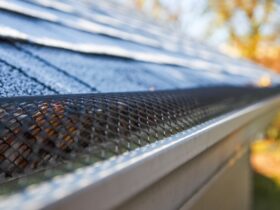Many, if not most, homeowners believe, quite simply, that a roof is a roof and don’t focus too much attention on the type of roof that is installed on their property. It’s likely that most homeowners won’t know the difference between a tiler and a slater, or what different types of roof are made from.
Should you experience a defect, you might opt to search for a few roofing firms local to your area and call them up for a quotation. Still, you may not be aware that slating and tiling are two entirely different trades and thus demand different methods, techniques, training and specifications.
They each require a completely different skill set. It may seem like an exaggeration, but if you employ your average tiler of news roofs to install your slate roof, then you may as well have called a plumber out instead.
Should the tiler install slates the same way that he installs his tiles, then your roof is likely to fall short of its expected lifespan. Furthermore, the tiler will be accustomed to carrying out his work much more quickly than a slater, with a different material and without as much attention to detail.
Unfortunately, many roofing tilers will simply proceed with installing the slate roof nevertheless, as they won’t want to turn down the work. There have been many horror stories relating to tilers’ provision of slate roofs; hence, it is vital that you learn the difference between tiling and slating and so avoid hiring the wrong contractor for your roof.
This video shows a recent Spanish slate installation in Hexham, Northumberland.
So, what is a slate roof and what is a tiled roof?
Slate, in a nutshell, is a metamorphic rock sliced into layers shaped into the rectangular slates often seen on roofs. There are vast amounts of slate underneath the earth’s surface, and this slate is extracted from quarries.
Historically, the most common slates for roofing purposes are mined in Wales, Spain, China and Brazil. However, slate can be and, indeed, is used for many purposes other than just roofing. This is due to the material’s ability to split with ease, as well as its strength, durability, resistance to water and hardwearing properties, along with the fact that it does not discolour easily.
Roof tiles are more in demand than ever – mainly because, these days, they are cheaper and easier to obtain. They are regularly made from concrete or clay, with concrete the more common and less expensive of these two options.
It has been said that neither would last as long as a well-installed slate roof, although both possess the properties to ensure a strong, watertight roof when installed by a competent roofer.
Why choose slate?
This will all depend on where you live, the character of your property, your budget and what currently inhabits your roof space.
If you are currently considering slate solely on the basis of cost, then stop right there! It would not be the right choice of material for you.

Natural slates cost more per singular tile than any other material, and you would require more slates per square meter than most, if not all, concrete and clay tiles. This means that the project is going to demand a greater cost before you even take any of the other variables into consideration.
There do remain some more affordable manmade slates which are available on the market and designed to emulate the look of natural slate. However, they differ in performance and lack the durability to withstand over 90 years of UK weather, as slates have been proven to do for centuries.
If you happen to occupy a property in a conservation area, then you may be restricted in the choices of tiles to which you can change, and any works will almost certainly demand a like-for-like amendment. Should you live on a street full of slate roofs, especially on a row of terraced properties, then changing to a tile of a different profile, size and colour will stand out and could clash with the overall character of your property and the street.
Not only this, but changing these characteristics may come to cause complications where your roof joins neighbouring homes. Most houses will have been designed to carry the weight of the tile or slate with which they were constructed; therefore, changing this will alter the dead load, and so the structural integrity of your property may be compromised.
In this scenario, bear in mind that you could be acting against building regulations. As a result, your roof may be checked over by a building inspector who acts on their authority to tell you to change the roof should it not be compatible with what your property requires.
It has been known for a customer to change from a slate roof to concrete tiles, only to be instructed to change back because the new roof is too heavy for the property to hold. It’s a well-known fact in the roofing industry that a well-installed slate roof should comfortably outlast its competitors and comes with a greater product guarantee from suppliers in the UK.
Preparing to install a slate roof
It bears emphasis that slating is its own trade; therefore, you should select your roofer as carefully as you would select your tattooist. If you choose the cheapest and least experienced company to do the job, then you will have to live with the consequences.
It will cost you more to fix a problem that should not have arisen had the roof been installed correctly in the first place. Undoubtedly the most crucial part of the job is the preparation that goes into it beforehand – and, whether you opt for new slates or wish to re-use slates, each slate should be examined individually to ensure that none which are broken, cracked or damaged will be used.
The next stage is pivotal to correctly installing a new slate roof, and is called grading. Slates need to be graded, and an experienced slater with an eye for detail can take just 2 to 3 days to grade all of the slates to be used for your roof.
You should aim to stack the slates up ready to fasten down in order of thickness, with thicker slates lower down towards the guttering and thinner slates higher up the roof towards the ridgeline. This provides a flush, watertight finish so that, when the traffic of water runs down the roof, the lower levels are well-protected, and can divert the water freely away into your gutters.
It also means that particular tiles won’t be raised higher than others, leaving no gaps for driving rain to enter behind. As you can imagine, it requires patience and experience to grade slates – traits that many tilers aren’t taught or naturally possess, making grading a stage that they will often omit.
Additional eaves slates and laths are also required, so your roofer must ensure that they have the correct volume of materials needed for the installation. These materials must also fit in such a way that they leave a minimum headlap of three inches.
With most concrete tiles, it is normal procedure to only nail them down every three courses, whereas every single slate on a slate roof needs to be nailed down. The job cries out for someone who is willing to take their time and not rush the process, as the margin for error is very small.
Lead soakers are needed wherever the roof meets an abutment, and all old lead work should be changed whenever you renew your roof. Many roofers will not change the lead work, which is bad practice – and, although they will be glad to accept payment for replacing 90-year-old slate, they may overlook the fact that the lead work, too, is 90 years of age.
The stage of changing the lead work could only be neglected by someone who lacks the knowledge and experience to acknowledge the importance of that leadwork’s inclusion or someone who is looking to save on expense because lead is by no means cheap.
The picture shows the stacking of manmade slate known as Rivendale slate.
Common mistakes made by inexperienced roofers

Use of the wrong nails – This mistake can decrease the longevity of your roof, and one of the main failures later down the line would be nail sickness. Aluminium, stainless steel and copper should be advocated as preferred materials and would stand the best possible chance of lasting as long as the tiles.
Wrong felt – Would you really go to the expense of purchasing £20,000 worth of new slates only to then cut corners and buy cheap felt? Bitumen-based felts simply perish too soon. You’d do best to make sure you are getting a new, non-perishable, 162g breathable membrane that is perfectly suited to slate roofing.
Failure to replace lead work – As mentioned previously, lead work and lead soakers should be renewed as part of your new roof. If the tradesman fails to do so, this could save them a fortune but cost you dearly. Do your homework and make sure you are getting lead of the right thickness around both chimneys and flashings.
Unsuitable scaffolding and access – Nobody likes scaffolding. It is both expensive and unsightly, but it is important that your roofer hires the right scaffolding firm. Cheaper, more basic scaffolding won’t cut it, because the roofer should not and must not be left to walk across your slates at any point. Allowing them to do so will end in tears.
Quality of slate – Roofers who persist with offering you the cheapest slates or tiles they can get their hands on probably don’t have your best intentions at heart. Honest advice is required about the quality of the slates available and whether they may contain impurities such as pyrite. It all depends on your roof, of course, but we would advocate some grades of Chatsworth first-class Spanish slate as well-suited to a roofing solution for the long term.
Grading – Grading is vital. You can buy pre-graded slates, but it will cost you a lot more, and the grading won’t be as precise as it would be from a roofer who grades them on-site.
Wrong headlap – A lack of headlap can be inconvenient for your slates, and a minimum headlap of 3 inches is advised, though this will all depend on the pitch of your roof. The slates should also be punched rather than drilled.
Is your roofer looking to do the best job?
You may have all the confidence in the world about your choice of roofer, but you must bear in mind that, for each job they seek, they will have a lot of competition – with, often, three other companies fighting it out for that single job. For this reason, many roofers tend to price as low as possible in order to win the business, partly because every customer wants to pay less.
Getting a good deal is great, but not at the cost of a substandard installation. It’s not really a good deal if the roofer must cut back on both materials and time in order to make a profit from the job. You pay for what you get – and, if a roofer fails to offer you a package covering the time, effort, skill and quality of materials your slate roof deserves, he cares merely about securing work.
If you focus on looking for company that specialises in slate, this will ensure that you are contacting the right companies. With any roofer who arrives at your property to give an estimate, don’t be afraid to ask them about previous jobs they have completed in your area or on roofs similar to the type you seek. You should also ask what projects the roofer is working on at the moment.

You never know – the roofer may invite you to see their fitters in action. Smaller one- or two-staff companies will probably not have the resources or financial backing to manage a project such as slating – and, because of the financial risk at stake, you can’t afford for this to go wrong. Therefore, it may be better for you to reach out to a larger firm with a solid reputation.
Findley’s Roofing & Building has separate departments for slating and tiling and would never consider taking a team from one side to try their hand at working on the other. This firm’s slaters are both experienced and well-qualified; they also install slate roofs day in, day out to the Findley specification. The company, which offers slate roofing in Newcastle as well as many other areas of North East England, can be reached by phone on 0191 417 3422.
Should you have any concerns over your slate roof, be careful which roofing company you call. Remember to peruse their website and, if they have their own YouTube channel, this as well. You might be able to see videos of their roofers in action and slate work that they have provided.







